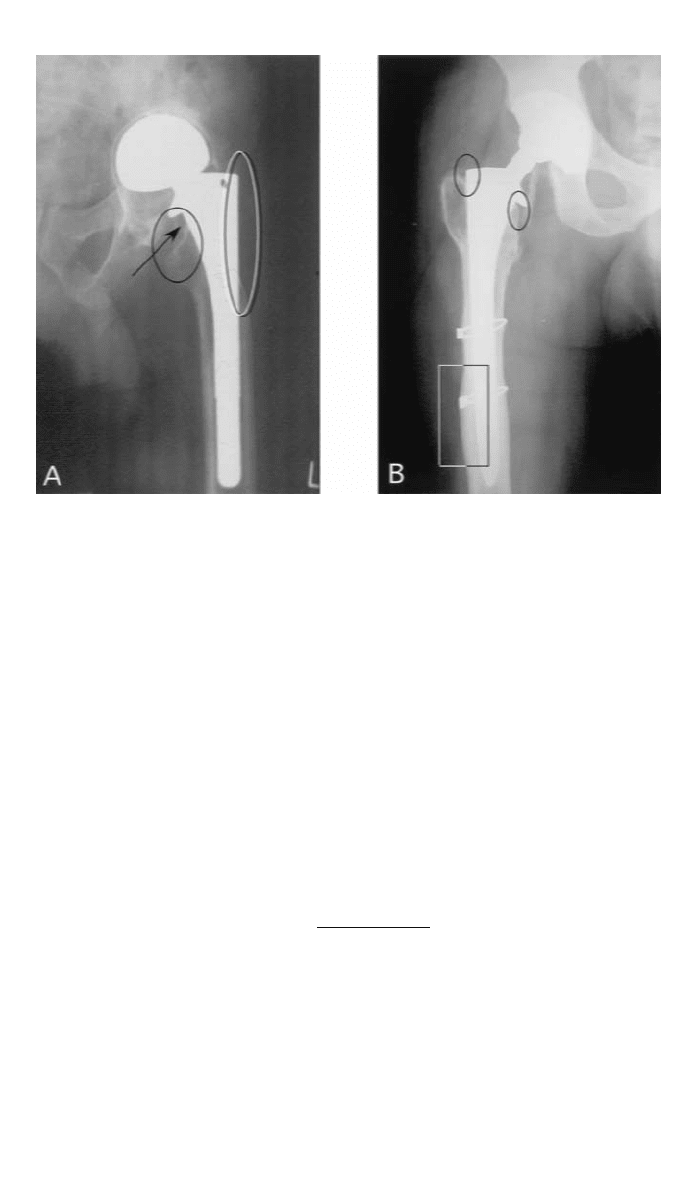Kutz M. Handbook of materials selection
Подождите немного. Документ загружается.


2 ORTHOPEDIC BIOMATERIALS: TOTAL HIP ARTHROPLASTY 1169
to develop testing methodologies for this purpose, and many have been compiled
by the American Society for Testing and Materials (ASTM), the International
Standards Organization (ISO), and other bodies interested in standardization. For
instance ISO-7206 (1989) discusses many aspects of testing for partial and total
hip replacements. Thus, individuals who are working to design new materials
for biomedical implants do not need to reinvent the wheel when it comes to
evaluation tests.
Finally, when the mechanical strength of a potential implant material is eval-
uated, the failure behavior of the material must be taken into consideration. The
ability of the material to absorb energy during potential abnormal loading events,
such as a fall or a jump, will affect its overall, long-term performance. Metals
are significantly less brittle than ceramics, and as a result are less likely to fail
during a high-energy or high-rate loading event. Ceramics are also more sus-
ceptible to failure in bending than metals, due to their relatively low tensile
strength and low resistance to crack propagation. These factors do not eliminate
ceramics from consideration for orthopedic implants; however, an understanding
of a material’s behavior under a range of loading modes and rates is needed
before a final determination of its suitability for a particular application can be
determined.
Stress Shielding. In bony prosthetics, exceeding the minimum strength re-
quirements of the application is not the only mechanical behavior of concern.
Bone is a living tissue and not merely a structural material. As a result, bone
changes in response to its loading environment. In 1892, Wolff first noted that
the pattern of the trabecular bone in the head and neck of the femur was similar
to the stress trajectories of a Culmann crane, an engineering structure with a
similar loading pattern (Wolff, 1892). Based on this observation, Wolff hypoth-
esized that bone develops and remodels in response to the load that it experi-
ences. Over 100 years later, Wolff’s law is still the governing principle behind
our understanding of how bone behaves in response to stress. In general terms,
bone requires a minimal, time-averaged stress in order to maintain its mass. If
the stress falls below this threshold level, bone will be lost. If the stress increases
beyond this threshold, bone will be added until the stress experienced returns to
its ‘‘desired’’ level. This is evidenced by the loss of bone seen in individuals
after sustained bed rest or in astronauts after missions spent in low-gravity en-
vironments.
As a result of this characteristic property, bone is susceptible to a phenomenon
termed stress shielding. This occurs when the stress in bone is reduced below
its maintenance threshold as a result of the mechanical role of an implanted
structure. Figure 3a shows the radiograph of a femur in which significant bone
loss has occurred around the proximal end of the implant, with stress shielding
being one of the underlying causes. Bone loss such as this is one of the leading
reasons for implant failure and revision. The formation of a callus at the distal
end of the implant, as also shown in Fig. 3b, is additional evidence of the
response of bone to its stress environment. In many hip implant designs, while
the stress in the bone in the proximal region of the implant is reduced, an
increase in stress is seen in the distal region that results in the deposition of
additional bone.

1170 SELECTION OF MATERIALS FOR BIOMEDICAL APPLICATIONS
Fig. 3 X-rays of hip implants showing changes in bone mass resulting from stress shielding
around an implant. (A) Circled areas indicate regions of significant bone loss in the proximal
region of the femur. The arrow indicates the area where the collar of the prosthesis is no longer
in contact with bone on the medial side. (B) Proximal bone loss (indicated in the circled regions
at the edge of the prosthesis) is accompanied by increased bone deposition (indicated by the
rectangle) in the distal region of the implant. The latter phenomenon is caused by increased
stress transfer in this region.
In any loaded structure consisting of two or more materials, the distribution
of stress and strain between the component materials will depend on their ge-
ometric arrangement and relative material properties. For a structure in which
the materials are in parallel with the loading axis and where the materials are
sufficiently well bonded—such as a well-fixed femoral implant—it can be as-
sumed that the materials deform to the same extent and therefore experience the
same strain. In this isostrain condition, the stress in one of the components of a
two-phase composite can be calculated from the equation:
EP
11
⫽ (1)
1
EA ⫹ EA
11 2 2
where P is the total load on the structure, and E and A are the Young’s modulus
and cross-sectional area of each of the components. Thus, the fraction of the
load carried by each material, and the resulting stress, is related to its Young’s
modulus and cross-sectional area in relation to those of the other components
of the composite structure. The stiffer materials in the composite will carry a
greater proportion of the load per unit cross-sectional area.
As stated above, the important parameter for maintenance of bone is the stress
that it experiences compared to a threshold value. If bone in its natural state is
compared to bone with an implant, the effect of this intervention on the stress

2 ORTHOPEDIC BIOMATERIALS: TOTAL HIP ARTHROPLASTY 1171
in the bone, and therefore its remodeling response, can be estimated. For a
femoral implant, or a bone plate as another example, the implant is in parallel
with the bone tissue with respect to the main loading axis. Therefore, Eq. 1 can
be used to estimate the effect of the implant on the stress in the bone. The
applied load can be assumed to be the same pre- and postimplant, which yields
the following equations for the stress in the bone in the two configurations:
Preimplant (E
implant
⫽ 0; A
implant
⫽ 0)
EP P
bone
⫽⫽ (2a)
bone
EA A
bone bone bone
Postimplant
EP
bone
⫽ (2b)
bone
EA ⫹ EA
bone bone implant implant
Thus, the stress in the bone is reduced by the inclusion of the implant, with the
amount of the reduction dependent on the modulus and area of the implant.
Implants with a higher modulus and a larger cross-sectional area will shield the
bone from a greater proportion of its normal, physiological stress, resulting in
bone loss according to Wolff’s law.
Joint Motion
Friction. Frictional forces between the articulating surfaces of a joint have
two primary effects: (1) to increase the muscle force required to overcome the
internal friction and allow motion to occur and (2) to increase the torque ex-
perienced by the implant and/or bone, such as at the location of the femoral
neck. Large internal bending moments due to high frictional forces may lead to
failure of the implant, and therefore should be avoided.
The natural joint, with its cartilage bearing surfaces and synovial fluid lubri-
cation, possesses a remarkably low coefficient of friction that minimizes the
tangential and bending forces at the joint. It has been recognized that, in an
artificial hip, the coefficient of friction between the femoral head and the ace-
tabular cup must be minimized in order to most closely approximate the normal
physiology. While no material combinations currently provide a coefficient of
friction of the level seen naturally, a number of options have been identified that
provide sufficiently low friction forces in the joint. Table 2 provides the coeffi-
cients of friction of some commonly paired materials used in hip replacement
in comparison to the natural state. Once implanted, the joint will be lubricated
with physiologic or synovial fluid, although it will no longer be contained within
the original joint capsule. Therefore, the friction values provided were measured
using physiological fluid or bovine albumin as a lubricating material. Alumina
has a relatively high surface tension, allowing it to develop a good lubrication
film that minimizes friction in vivo (Ravaglioli and Krajewsk, 1992).
As friction forces are proportional to the coefficient of friction and the normal
force between the contact surfaces, the loading configuration of an implant will
also determine the forces that influence joint motion and applied bending mo-

1172 SELECTION OF MATERIALS FOR BIOMEDICAL APPLICATIONS
Table 2 Coefficient of Friction for Sample
Material Combinations Used in Total Hip
Replacement
a
Material Combination Coefficient of Friction
Cartilage/ cartilage 0.002
CoCr/ UHMWPE 0.094
Zirconia/ UHMWPE 0.09–0.11
Alumina/ UHMWPE 0.08–0.12
CoCr/ CoCr 0.12
Alumina/ alumina 0.05–0.1
a
UHMWPE, ultra-high-molecular-weight polyeth-
ylene; CoCr, cobalt–chromium alloy.
Source: Data from Park and Lakes (1992), Strei-
cher et al. (1992).
ments. Therefore, materials that will provide a sufficiently reduced friction en-
vironment for a relatively low force location, such as the wrist, can result in a
friction force in the hip that may cause implant failure to occur or cannot be
adequately overcome by normal muscle forces to allow unhindered motion.
Thus, once again, the specific application of an implant must be considered when
selecting materials—generalized assumptions and choices do not necessarily
produce the optimum selection.
Wear. Whenever contact surfaces and motion are combined, material wear
must be taken into consideration. Wear is the process whereby one object,
through motion, removes material from the surface of the contacting object.
Generally, the harder material will cause wear to occur on the softer material.
Three basic types of wear can occur: abrasive wear, adhesive wear, and third-
body wear. Abrasive wear exists when a hard material, such as a metal, moves
cyclically against a soft material, such as a polymer. Adhesive wear involves the
sliding motion of two similar materials, where molecular bonds can be formed
at the interface of the structures. In rough materials, the surfaces appear as a
series of peaks and valleys. The two articulating surfaces typically come into
contact at the peaks of the surface roughness, concentrating the contact load
over a much smaller area and increasing the contact stress. As the molecular
bonds between the objects are broken through motion, they also break off par-
ticles of the underlying material. Third-body wear includes the effect of particles
between the articulating surfaces that tend to accelerate wear.
The amount of wear that occurs between two surfaces will depend on several
factors: (1) the hardness of the two materials (p), (2) the normal force at the
surface (F
n
), (3) the Archard coefficient for the pair of materials (k), (4) the area
of contact between the surfaces during the cyclic motion, and (5) the number of
cycles expected. Archard’s coefficient is similar in concept to the coefficient of
friction and describes the degree to which a normal force at the surface is trans-
lated into a wear-producing force. A harder material will always sustain less
wear when in motion against a given surface than a softer material. As two
materials sweep out a larger surface of contact for each cycle of motion, there
will be a greater fraction of the surface area experiencing wear, thus resulting

2 ORTHOPEDIC BIOMATERIALS: TOTAL HIP ARTHROPLASTY 1173
Fig. 4 Illustration of the development of a new socket within an
acetabular cup due to excessive wear.
in an increase in the overall rate of wear. And, with little explanation required,
if a given amount of wear occurs per cycle, then an increased number of cycles
will result in a greater total amount of wear.
The wear rate, or volume of wear particles produced (V), can be approximated
for adhesive wear by the equation:
kF x
n
V ⫽ (3)
3p
where x is the total sliding distance between the surfaces (Black, 1999). The
total sliding distance can be determined for a single cycle, a defined period of
time (e.g., one hour), or estimated for the entire life of the implant, thus allowing
for the calculation of a rate for wear particle production.
Wear can be exacerbated through corrosion or fatigue processes, indicating
that in vivo wear rates may differ from those measured in laboratory. The oc-
currence of wear in an implant may affect both its mechanical function and the
response of the body to the implant. The former will be discussed here, while
the effect of wear debris will be described in the discussion of biocompatibility.
As wear occurs on one or both of the opposing surfaces of an articulating
joint, the shape of the implant may change as material is removed. This is
especially evident when significant wear occurs in a polymeric acetabular cup
within a total hip replacement. Figure 4 shows how significant wear can result
in the creation of a new socket, typically with a reduced diameter. This change
in the configuration of the acetabulum can affect the range of motion of the hip
as well as whether any joint impingement occurs. As the socket deepens, the
femur will shift upward, which will increase the laxity of some of the ligaments
and tendons, thus affecting overall joint performance.

1174 SELECTION OF MATERIALS FOR BIOMEDICAL APPLICATIONS
Table 3 Ideal and Practical Electrochemical Series for Common Metals
a
Ideal Series
Half-Cell Potential (mV) of Ideal Series with
Respect to H / H⫹ Half-cell Practical Series
Cathodic
Gold
⫺1.50 Platinum
Platinum
⫺0.86 Gold
Silver
⫺0.80 Passivated stainless steel
Copper
⫺0.47 Titanium
Lead 0.12 Silver
Tin 0.14 Unpassivated stainless steel
Nickel 0.23 Copper
Iron 0.44 Tin
Chromium 0.56 Lead
Aluminum 1.70 Wrought iron
Titanium 2.00 Aluminum
Magnesium 2.40 Magnesium
Anodic
a
The half-cell potentials listed are for the ideal series and are with respect to a H / H
⫹
half-cell.
Source: Data from Black (1999), Park and Lakes (1992).
2.2 Biocompatibility
Once a material is selected for an implant application based on the functional
requirements, it must be evaluated in terms of material–body interactions.
An implant material will react chemically with the local environment, with
the type of reaction dependent on the class of material. Metals are susceptible
to corrosion, polymers experience leaching and absorption, while ceramics are
generally considered to be chemically inert—unless designed to be bioactive.
The effects of chemical degradation may affect both the tissue and the material
itself, especially its mechanical properties, and so both aspects must be consid-
ered. In addition, degradation products can affect the physiology locally, at a
remote location, or systemically.
Corrosion
Metallic materials are susceptible to corrosion, particularly in the ionic fluid
environment of the body. To assess the corrosion potential of a metal, it is
necessary to examine the half-cell potential of that metal—which will act as an
anode when it releases electrons—with respect to the material acting as the
cathode. This cathode may be another metal or the ionic environment itself. An
electrochemical series lists the half-cell potentials of metals in order from the
most noble (or cathodic) to the most anodic. When two materials are in contact
with each other directly or through an ionic solution, the metal listed first in the
list will act as the cathode while the other will behave as the anode. Practical
electrochemical series typically relate half-cell potentials as measured in an ap-
plication-specific environment and may include alloys. This contrasts with ideal
series, which list only pure metals as measured with respect to a hydrogen half
cell reaction. The ideal series approximates the behavior of metals in pure water.
Table 3 shows the half-cell potentials of common metals as measured in an ideal

2 ORTHOPEDIC BIOMATERIALS: TOTAL HIP ARTHROPLASTY 1175
Fig. 5 Pourbaix diagram for chromium in aqueous solution of 1 N Cl
⫺
. The diagram indicates
the electrochemical environment of various regions of the body. [From John H. Dumbleton and
Jonathan Black, An Introduction to Orthopaedic Materials, Thomas Publishing,
Springfield, IL, 1975, with permission].
electrochemical series, as well as the qualitative series of metals in a saltwater
solution. This latter series reasonably approximates what would be found in the
body, where sodium chloride is a major constituent of the ionic soup.
The low half-cell potentials of gold and platinum are a result of their essential
inertness. For other materials, their resistance to corrosion may be due to the
formation of a protective oxide layer on the object’s surface. A second way to
determine how a metallic material is likely to behave in vivo from a chemical
standpoint is to examine Pourbaix diagrams that have been developed based on
theoretical chemical relationships. These curves, such as the one shown in Fig.
5, describe the expected corrosive behavior of materials as a function of pH and
the surrounding electrical potential. By determining the expected environment
at an implant site, it is possible to predict which materials are likely to meet the
outlined requirements for implantation. In regions of buffered pH, which are
common within the human body, the partial pressures of O
2
and H
2
can be used
to estimate the electrical potential at the site (Black, 1999).
Three general behaviors can exist for a metallic material in an ionic environ-
ment: corrosion, passivation, or immunity. Corrosion is the chemical reaction in
which a metal is oxidized, producing metallic ions within the fluid environment.
As a metal corrodes, it can effect both the overall implant properties—resulting
in premature failure—and the body. In the latter case, the ions produced through
the oxidation reaction can interfere with the normal physiologic process of the
body at either a local or a systemic level. It cannot be assumed that the ions
produced will have no adverse reaction in the body if they are normally present
in trace amounts. For instance, iron, a mineral required for normal red blood
cell production, will prove to be toxic at elevated concentrations in the body,
causing liver and pancreatic failure (Smith, 1983). Therefore, it is important to
select materials that will exist within their passivation or immunity regions in
the in vivo environment. Passivation is the creation of a protective, oxide or

1176 SELECTION OF MATERIALS FOR BIOMEDICAL APPLICATIONS
hydroxide layer on the surface of the metal. Immunity is the region in which
minimum oxidation is going to occur as the equilibrium concentration of metallic
ions is low. (The equilibrium concentration refers to the levels of ions in the
immediate, surrounding environment at which the oxidation reaction reaches
equilbirium, thus producing no further net release of ions.) Both passivation and
immunity require that less than 10
⫺
6
M of ions be produced (Park and Lakes,
1992). Thus, in neither of these cases is oxidation eliminated for a metallic
material; however, the effect on the implant’s properties and the ion concentra-
tion produced will be negligible. As a final check of biocompatibility, it is im-
portant to ascertain that the trace levels of ions produced by passivated or
immune metals will not produce toxic effects at even those low concentrations.
Pourbaix diagrams can only provide information on the ideal behavior of a
metal within its immunity or passivation regions. As the limitation of corrosion
in these environments is due to the establishment of a chemical equilibrium, the
ionic environment of the implant surface and the surrounding physiologic fluid
must remain undisturbed. Therefore, any damage to the passivation layer, or any
fluid flow that removes the equilibrium ions from the region immediately adja-
cent to the implant, may cause renewed corrosion. Cyclically loaded implants
could be expected to experience both surface damage, due to wear or contact
with other tissues, and movement of the fluid surrounding the implant. In ad-
dition, the local pH at a site may be affected by common physiologic insults,
such as injury and infection. Finally, most Pourbaix diagrams are determined
for pure water environments, and therefore do not include the role of additional
ionic components in the physiologic fluid. This would also be expected to influ-
ence the corrosion behavior of a material. Therefore, the behavior predicted by
the Pourbaix diagrams may be taken as a base line expectation, but must be
confirmed through both animal and clinical testing.
Some additional rules can be applied to minimize the occurrence of corrosion
for an implant with metallic components. These are:
1. Minimize the number of different metals used in the implant. Two metals
that differ in electrochemical potential, due to differences in elemental
composition or processing, will create a galvanic potential when con-
nected either directly or through an ionic fluid. This can include parts
manufactured of the same material but by different companies or different
techniques, as the processing schedule may differ enough to create dif-
ferences in the electrical potentials of the components.
2. Minimize the possibility of surface damage. Any scratches to the surface
of a metallic implant can serve as foci for corrosion once it is implanted.
Thus, it is important to protect the implant from the stage of final proc-
essing through implantation to prevent damage.
3. Reduce the number of crevices or regions where oxygen depletion is pos-
sible. A region with a low-oxygen concentration, such as the interfaces
between modular components of a total joint implant or the threads of a
bone screw, is likely to become anodic with respect to the surrounding
metal—even with respect to the remaining bulk of the metal. Corrosion
will therefore occur with the small, anodic region providing electrons to

2 ORTHOPEDIC BIOMATERIALS: TOTAL HIP ARTHROPLASTY 1177
the entire cathode. If there is a discrepancy in the size of the regions, as
would normally be expected, then corrosion within the crevice can be
accelerated, leading to potential mechanical failure.
Leaching and Absorption
Polymers placed in a fluid environment can experience two opposite phenomena.
In leaching, unreacted monomer molecules, fillers, or small chains of polymers
can diffuse from the bulk of the polymer to the surrounding fluid. As in corrosion
products, these released molecules may have a negative effect on the local phys-
iology or, if transported through the bloodstream or lymphatic system, on sys-
temic or remote processes. In addition, significant leaching may reduce the
density of the polymer and consequently have an adverse effect on the properties
of the structure. Absorption occurs when water molecules, proteins, or lipids
diffuse from the fluid into the mass of the polymer. The absorbed molecules
become distributed between the molecules of the polymer, reducing the me-
chanical strength of the structure and increasing its susceptibility to wear.
Both absorption and leaching occur as a result of diffusion processes across
the surface of the implant. Fick’s first law of diffusion describes the rate of
solute transfer across a permeable barrier:
⭸C
F ⫽⫺D (4)
冉冊
⭸x
where F is the rate of solute transfer per unit cross-sectional area of the surface,
D is the diffusion coefficient, and
⭸C/⭸x is the concentration gradient. The dif-
fusion coefficient is dependent on the solute (the molecule that is being absorbed
or released), the matrix through which it is moving (the remainder of the bulk
polymer), and the type of diffusion that is occurring. Thus larger molecules
moving through more tightly bonded matrices are likely to leach out at a lower
rate than small molecules diffusing through a more open, amorphous structure.
All materials, including metals and ceramics, can absorb molecules—
particularly water—from the surrounding environment. However, this occurs
much more readily in the relatively loosely bonded polymers. Absorption in
polymers can also result in swelling, due to their low elastic modulus, which
may cause geometric changes that interfere with the performance of an implant.
The strain that a polymeric object experiences due to swelling may induce cracks
and may also reduce the ultimate strength of the object. This latter phenomenon
occurs because, due to the new baseline strain in the material, less stress is
needed to reach the material’s ultimate strain. If the absorbed molecules are
small, such as water, they will act as plasticizers and weaken the bonds between
the polymer chains, thus reducing the Young modulus of the material. If a pol-
ymer is hydrophobic in nature, it is less likely to absorb water. However, ab-
sorption of nonpolar molecules such as lipids may still occur.
Leaching generally has a smaller effect on the mechanical properties of a
polymeric structure than absorption. However, as was the case in corrosion, local
changes in properties may occur as material is lost. In fact, if sufficient leaching
occurs to create adjacent or expanded voids within the chemical structure of the
polymer, these regions may act as stress risers. A high amount of leaching will

1178 SELECTION OF MATERIALS FOR BIOMEDICAL APPLICATIONS
act to increase the porosity of the polymer. In both of these cases, the elastic
modulus and the mechanical strength of the polymer would be affected.
In general, low-molecular-weight or highly amorphous polymers are more
susceptible to leaching or absorption processes than high-molecular-weight,
highly crystalline, or highly cross-linked polymers. As diffusion coefficients in-
crease for smaller molecule sizes, in general, it can be expected that additives
and free monomers have a higher rate of leaching than the large polymer chains
themselves, while the relatively small water molecule will be absorbed by hy-
drophilic polymeric structures at a relatively high rate. The behavior of free
monomers and additives within polymers is of particular interest, as they may
have a different effect on the surrounding tissue than tests based on the bulk
polymer suggest. In fact, free monomer should be expected to have a different
physiologic effect than molecules that have reacted to form the bulk polymer,
due in part to the difference in chemical reactivity of the structures.
Wear Debris
The material produced through the wear process is typically in the form of
particulate debris. The size of the particles is dependent on the material involved
and may range from submicon dimensions to millimeter-sized pieces. In poly-
ethylene, particles typically range from 0.5 to 50
m in their largest dimension,
while polymethylmethacrylate (PMMA, bone cement) particles tend to be sig-
nificantly larger (Willert and Semlitsch, 1996). These particles can have several
adverse effects on implant performance beyond the geometric changes discussed
above. First, if the debris becomes trapped between the articulating surfaces of
the joint, it will act as a collection of third-body particles to accelerate the wear
process. Second, the presence of particulate debris in the tissue surrounding the
bone triggers an immune response that can result in significant bone loss through
the process of osteolysis. When this occurs without an associated infection, it is
termed aseptic loosening. The presence of histiocytes, macrophages, and foreign
body giant cells in locations with both mild and severe osteolysis indicate that
the process is inflammatory or immunological in nature. It is currently hypoth-
esized that the presence of particulate debris results in macrophage and giant-
cell recruitment (Jacobs, et al., 1994). The larger particles are engulfed by giant
cells through phagocytosis and form granulation tissue, while macrophages react
with the smaller particles. Normally, foreign debris on a small scale will be
removed through the lymphatic system. However, if the volume of debris pro-
duced overloads the lymphatic system, then macrophages at the implant site may
release cellular mediators that trigger the bone resorption observed.
2.3 Current Material Selection
The traditional materials that have been used for total hip arthroplasties are ultra-
high molecular-weight polyethylene (UHMWPE) for the articulating surface of
the acetabular cup and a metal, today typically an alloy of titanium or of cobalt–
chromium, for the femoral stem, head, and backing of the acetabluar cup. In a
smaller number of designs, ceramics such as alumina (Al
2
O
3
) and zirconia
(ZrO
2
) have been used for a modular femoral head component, both to reduce
friction within the acetabulum and minimize the number of metallic components
that may exacerbate corrosion. Table 4 provides a summary of some of the
